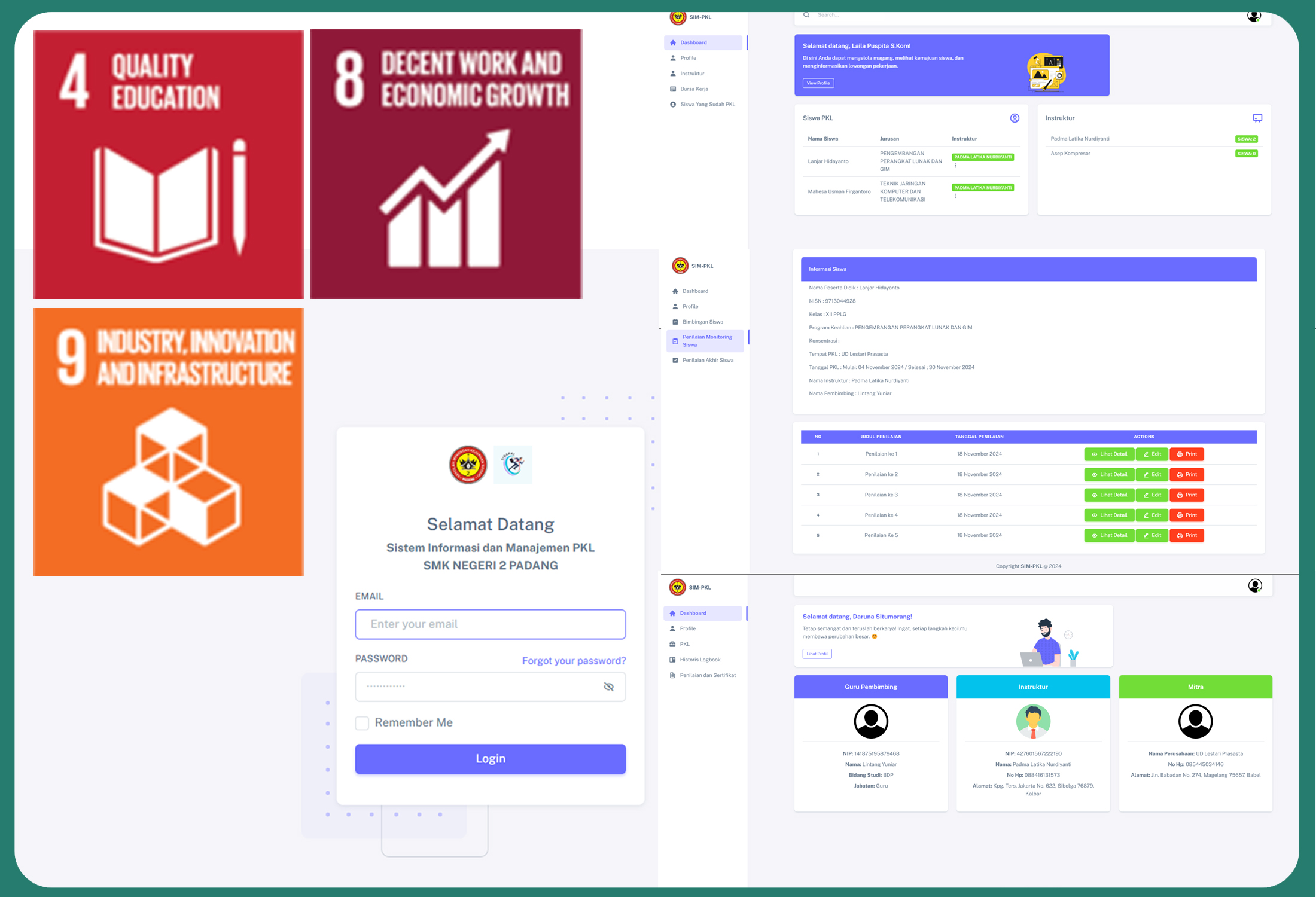Design and Implementation of a Web-Based Internship Management Information System for Vocational Education
DOI:
https://doi.org/10.24036/javit.v5i2.243Keywords:
Internship Management System, Vocational Education, Laravel, Selfie Verification, Waterfall ModelAbstract
The integration of information technology in vocational education plays a vital role in improving the effectiveness and efficiency of practical learning programs such as Field Work Practice (PKL). This study aims to develop a web-based internship management information system that supports the organization, supervision, and evaluation of PKL activities in vocational high schools. The system was developed using the Laravel framework with PHP as the programming language and MySQL as the database management system. The Waterfall method was adopted to ensure a structured and systematic development process. Key features of the system include real-time student attendance tracking through selfie verification with geolocation, a digital daily journal, an integrated assessment mechanism, and automated certificate generation accessible by both school and industry mentors. The implementation of the system at SMK Negeri 2 Padang demonstrates its effectiveness in reducing the accumulation of physical documents and enhancing the monitoring and administration of internship activities. The results highlight the system's potential to improve the quality of internship management and provide a model for similar implementations in other vocational institutions.
Downloads
References
V. Kovalchuk, S. Maslich, N. Tkachenko, S. Shevchuk, and T. Shchypska, “Vocational Education in the Context of Modern Problems and Challenges,” J. Curric. Teach., vol. 11, no. 8, pp. 329–338, Jun. 2022, https://doi.org/10.5430/jct.v11n8p329.
S. McGrath and S. Yamada, “Skills for development and vocational education and training: Current and emergent trends,” Int. J. Educ. Dev., vol. 102, p. 102853, Oct. 2023, https://doi.org/10.1016/j.ijedudev.2023.102853.
F. Dahalan, N. Alias, and M. S. N. Shaharom, “Gamification and Game Based Learning for Vocational Education and Training: A Systematic Literature Review,” Educ. Inf. Technol., vol. 29, no. 2, pp. 1279–1317, Feb. 2024, https://doi.org/10.1007/s10639-022-11548-w.
C. F. Yeap, N. Suhaimi, and M. K. M. Nasir, “Issues, Challenges, and Suggestions for Empowering Technical Vocational Education and Training Education during the COVID-19 Pandemic in Malaysia,” Creat. Educ., vol. 12, no. 08, pp. 1818–1839, Jul. 2021, https://doi.org/10.4236/ce.2021.128138.
I. Suseno, “An Evaluation of Graduates’ Employment of Courses and Vocational Training Institutions,” J. Educ. Res. Eval., vol. 7, no. 1, pp. 23–34, Mar. 2023, https://doi.org/10.23887/jere.v7i1.47594.
D. Bender, “Internship assessment in professional program accreditation: a 10-year study,” Educ. Train., vol. 63, no. 2, pp. 256–270, Jan. 2021, https://doi.org/10.1108/ET-11-2019-0251.
F. Moeinzadeh, S. Ayati, B. Iraj, M. Mortazavi, and V. Vafamehr, “Designing, implementation, and evaluation of internship comprehensive system for assessment and monitoring,” J. Educ. Health Promot., vol. 10, no. 1, Jan. 2021, https://doi.org/10.4103/jehp.jehp_626_20.
P. W. Dandeniya Arachchige, “Students’ perceptions on auditing as a mechanism for enhancing the reliability and transparency in financial statements,” 2024, Accessed: Jul. 03, 2025. [Online]. Available: http://www.theseus.fi/handle/10024/864186.
A. Jahir, A. Mu, amar Wahid, T. Titis Sufranto, and K. Kunci, “Optimizing Higher Education Performance Through Data Integration Using the Zachman Framework: A Case Study on LAM Infokom Accreditation Criteria,” J. Nas. Teknol. dan Sist. Inf., vol. 10, no. 3, pp. 201–215, Jan. 2024, https://doi.org/10.25077/TEKNOSI.V10I3.2024.201-215.
S. Chaudhari and M. Shirole, “Blockchain-Driven Academic Learning Record Management in Higher Education: A Comprehensive Review of Methodologies, Applications, Benefits, and Challenges,” SN Comput. Sci., vol. 6, no. 5, pp. 1–33, Jun. 2025, https://doi.org/10.1007/s42979-025-03952-z.
Z. He and W. Fang, “Research data management in institutional repositories: an architectural approach using data lakehouses,” Digit. Libr. Perspect., vol. 41, no. 1, pp. 145–178, Jan. 2024, https://doi.org/10.1108/DLP-02-2024-0022.
Y. Javed and M. Alenezi, “A Case Study on Sustainable Quality Assurance in Higher Education,” Sustain., vol. 15, no. 10, p. 8136, May 2023, https://doi.org/10.3390/su15108136.
K. J. Nyitray and D. Reijerkerk, “Digital Repository Legacies: A Case Study in Assessing Organizational Trustworthiness,” J. Libr. Adm., vol. 61, no. 7, pp. 793–812, 2021, https://doi.org/10.1080/01930826.2021.1972729.
D. Naga Malleswari, M. P. Kumar, D. sathvika, and B. A. Kumar, “A study on SDLC for water fall and agile,” 2018. https://doi.org/10.14419/ijet.v7i2.32.13516.
S. Sanatang and M. F. B, “Sistem Tes Interaktif Berbasis Computerized Adaptive Testing (CAT),” J. Mediat., vol. 4, no. 1, p. 30, 2021, https://doi.org/10.26858/jmtik.v4i1.19726.
A. Huda, Firdaus, D. Irfan, Y. Hendriyani, Almasri, and M. Sukmawati, “Optimizing Educational Assessment: The Practicality of Computer Adaptive Testing (CAT) with an Item Response Theory (IRT) Approach,” Int. J. Informatics Vis., vol. 8, no. 1, pp. 473–480, Mar. 2024, https://doi.org/10.62527/joiv.8.1.2217.
M. Shoaib, N. Sayed, J. Singh, J. Shafi, S. Khan, and F. Ali, “AI student success predictor: Enhancing personalized learning in campus management systems,” Comput. Human Behav., vol. 158, p. 108301, Sep. 2024, https://doi.org/10.1016/j.chb.2024.108301.
I. E. Okokoyo, “Robotic Process Automation in School Administration: Exploring the Integration of RPA Solutions to Streamline Administrative Processes and Reduce Workload,” NIU J. Humanit., vol. 9, no. 2, pp. 71–80, Jun. 2024, https://doi.org/10.58709/niujhu.v9i2.1905.
M. Aly, “Revolutionizing online education: Advanced facial expression recognition for real-time student progress tracking via deep learning model,” Multimed. Tools Appl., vol. 84, no. 13, pp. 12575–12614, Apr. 2024, https://doi.org/10.1007/S11042-024-19392-5.
T. A. Kustitskaya, R. V. Esin, Y. V. Vainshtein, and M. V. Noskov, “Hybrid Approach to Predicting Learning Success Based on Digital Educational History for Timely Identification of At-Risk Students,” Educ. Sci., vol. 14, no. 6, p. 657, Jun. 2024, https://doi.org/10.3390/educsci14060657.
B. Razia and B. Awwad, “A Comprehensive Review of Blockchain Technology and Its Related Aspects in Higher Education,” Stud. Comput. Intell., vol. 1019, pp. 553–571, 2022, https://doi.org/10.1007/978-3-030-93921-2_29.
Z. A. Adhoni and D. L. Narayan, “Improving the interoperability of a Function-as-a-Service platform using an orchestration framework with a cloud-agnostic approach,” ETRI J., vol. 47, no. 2, pp. 312–325, Apr. 2024, https://doi.org/10.4218/etrij.2023-0443.
B. Abbasnejad, S. Soltani, F. Taghizadeh, and A. Zare, “Developing a multilevel framework for AI integration in technical and engineering higher education: insights from bibliometric analysis and ethnographic research,” Interact. Technol. Smart Educ., vol. ahead-of-print, no. ahead-of-print, 2025, https://doi.org/10.1108/ITSE-12-2024-0314.
M. Coeuret, J. Falip, and A. Bénel, “Cooperating in Academia with underspecified protocols: A case study of students and researchers practitioners of Grounded theory methodology (GTM).,” 2025, https://doi.org/10.48340/ECSCW2025_EP03.
A. Luştrea et al., “The Digital Reflective Journal: A Self-Assessment Tool for Higher Education Students,” Lect. Notes Educ. Technol., vol. Part F3676, pp. 259–283, 2024, https://doi.org/10.1007/978-981-97-6136-4_12.
G. D. Carlos and A. López, “The Systematisation of Survey Drawings: Identifying the Development of Morphological Awareness via Teaching Approaches,” Buildings, vol. 15, no. 5, p. 674, Feb. 2025, https://doi.org/10.3390/buildings15050674.
L. Guillaume, V. Laurent, and M. J. Genge, “Immersive and interactive three-dimensional virtual fieldwork: Assessing the student learning experience and value to improve inclusivity of geosciences degrees,” J. Geosci. Educ., vol. 71, no. 4, pp. 462–475, 2023, https://doi.org/10.1080/10899995.2023.2200361.
B. Persson and B. Hermelin, “Decentralised cooperation between industries and local governments in a statist skill-formation system: an analysis of industrial schools in Sweden,” J. Vocat. Educ. Train., vol. 74, no. 4, pp. 645–663, Oct. 2022, https://doi.org/10.1080/13636820.2020.1829007.
M. Vijayalakshmi, A. K. Subramani, R. Vettriselvan, P. R. Velmurugan, and J. Hasine, “Strategic collaborations in medical innovation and AI-driven globalization: Advancing healthcare startups,” Navig. Strateg. Partnerships Sustain. Startup Growth, pp. 85–110, Jan. 2025, https://doi.org/10.4018/979-8-3693-4066-0.ch004.
R. Trager et al., “International Governance of Civilian AI: A Jurisdictional Certification Approach,” SSRN Electron. J., Aug. 2023, https://doi.org/10.2139/ssrn.4579899.
J. I. Ricks and R. F. Doner, “Getting institutions right: Matching institutional capacities to developmental tasks,” World Dev., vol. 139, p. 105334, Mar. 2021, https://doi.org/10.1016/j.worlddev.2020.105334.

Downloads
Published
How to Cite
Issue
Section
License
Copyright (c) 2025 Muhamad Tegar Putra Perdana, Geovanne Farell, Titi Sriwahyuni, Lativa Mursyida

This work is licensed under a Creative Commons Attribution 4.0 International License.










